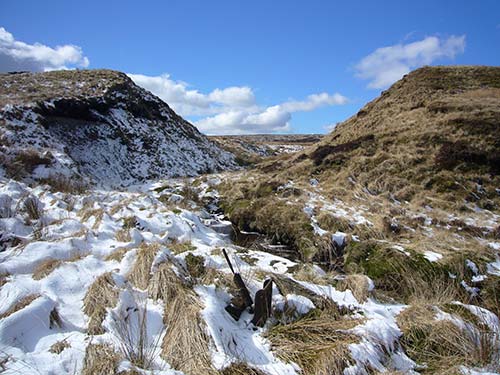Hebden Bridge Local History Society
The dam that isn't and the great floating plug of the Colden
Speaker: Dave Smalley
Monday, 13 December 2021
The Alan Petford Memorial Lecture
Each year Hebden Bridge Local History Society signals its debt of gratitude to local historian and extraordinary teacher Alan Petford, who died in 2015, by choosing a piece of original local history research as the Memorial Lecture. This year the work of Dave Smalley, which appeared in the book which honours Alan's legacy, was revisited in the lecture.

Dave's initial interest in the dam of Colden water situated high on the moors at Nodale (also Noahdale) was stimulated by a local legend of how it had failed catastrophically in 1936 and that a giant floating plug of dam wall could still be found in the landscape. A study of the site over many months and years revealed more about the way the dam had been originally constructed, and how its extension in about 1826 had built in its failure a century later.
Local history research often involves a synthesis of lucky finds in archives, context and comparative studies and painstaking interrogation of the existing landscape, looking for evidence of man-made interventions. Dave told of his lucky finds in archives, shedding light on the way the dam was financed, at a time of rapid expansion of the textile industry in the area. The financing of the industry required some hefty capital investment. In 1805 wealthy merchant and twice mayor of Leeds, Alexander Turner, bought the land at Nodale where the dam was constructed. An enormous £7000 loan taken out in 1810 by Turner and his father in law James King of Mytholm was probably used to finance the building of the dam to secure the water supply of their mills along the Colden.
Looking for clues in the landscape, especially in such a remote and hostile site, requires some knowledge of how such dams were built, and Dave studied the construction of comparative dams in order to make sense of what his searches were revealing. At this time there was expertise in building for the canals, using a sandstone blocks and a technique of packing earth and clay to produce a water-tight wall. Dave was able to identify how the dam had been expanded in 1826 by building a wall on top of the earlier dam, in a way far less able to withstand the pressure of the increased depth of water. Exploration of the site gradually revealed some of the cast iron pipework and the stone work which had been described in a survey of the dam in 1936. The supposed floating plug was revealed as part of an engineered spillway.
In assessing what caused the breakdown of the dam in August 1936 Dave turned to 20th century documents. First of all he was able to dismiss the idea that there may have been a freak weather event – rainfall records show a dry summer and only 3mm of rain on the day of the breach. It seems that the failure was caused by a combination of poor construction and poor maintenance.
The dam was owned by tenants in common: Todmorden RDC and Hebden Bridge UDC, whose records remain, and private owners John Clegg and John Pickles & Sons of Mytholm. Letters reveal serious concerns about lack of maintenance of the site in September 1935, when a leak was noted. The waterman who had been paid to check the dam had not been living near the area for four years and the dam wall was in a poor state of repair.
In June 1936 the dam failed more seriously, and the Todmorden surveyor Brearley Oldfield noted that he had let down the water by allowing it to escape. In August a portion of the embankment had given way and a statutory investigation reported that the upper section of the wall had flushed away. The poor construction of the 1826 raised wall revealed that no watertight puddled clay was to be found. Faced with the obligation to either repair or breach the dam, the joint owners decided to discontinue the services of the waterman and seemingly let the inevitable collapse happen.
One fascinating piece of oral evidence has also been woven into Dave's research: Eva Stansfield recorded in 1970s how as a girl she had run down to the Colden at Jack Bridge to watch 'the pash' of water when Nodale dam burst. As she was the niece of the Brearley Oldfield, it seems likely that it was the work of letting down the dam water in June that she saw and remembered. Letters, minutes, newspapers, indentures, contracts, maps, aerial images, photography, landscape investigation and reminiscences all provide fertile ground for the researches of a local historian.
At the next meeting of Hebden Bridge Local History Society Kate Higham will talk about the history of Hebden Bridge Cinema. All are welcome at Hebden Royd Methodist Church at 7.30 on Wednesday 12th January.
If there are new Covid restrictions, an alternative Zoom webinar will be advertised and members contacted by email.
Details of the talks programme, publications and of archive opening times are available on the History website and you can also follow the Facebook page.
With thanks to Sheila Graham for this report

